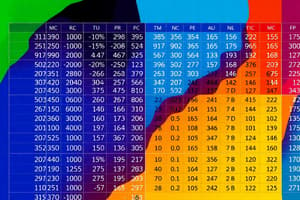Podcast
Questions and Answers
What does Excel lack compared to relational database management systems (RDBMS)?
What does Excel lack compared to relational database management systems (RDBMS)?
- Data storage in multiple sheets
- Support for many-to-many relationships (correct)
- Ability to perform simple lookups
- User-friendly interface
In Excel's Data Model, what type of relationship can be established between tables?
In Excel's Data Model, what type of relationship can be established between tables?
- Many-to-many and many-to-one
- One-to-many and one-to-one (correct)
- Only one-to-many
- One-to-one and many-to-many
Which of the following best defines a flat-file database?
Which of the following best defines a flat-file database?
- A single table or sheet without complex relationships (correct)
- A database that requires SQL for management
- A structure that uses multiple complex relationships
- A database that cannot store large datasets
What is the primary purpose of database normalization in Excel?
What is the primary purpose of database normalization in Excel?
What is a necessary practice to ensure data integrity when using Excel as a database?
What is a necessary practice to ensure data integrity when using Excel as a database?
Which of the following best describes 3NF (Third Normal Form) in database normalization?
Which of the following best describes 3NF (Third Normal Form) in database normalization?
What is an appropriate application of Excel as a database?
What is an appropriate application of Excel as a database?
What function in Excel is best suited to retrieve data from a specified range based on a matching key?
What function in Excel is best suited to retrieve data from a specified range based on a matching key?
Which feature allows for highlighting potential errors like duplicates or blank cells in Excel?
Which feature allows for highlighting potential errors like duplicates or blank cells in Excel?
Which of the following is a limitation of using relationships in Excel?
Which of the following is a limitation of using relationships in Excel?
What does each worksheet in Excel represent in the context of a flat-file database?
What does each worksheet in Excel represent in the context of a flat-file database?
What is a significant limitation of using VLOOKUP compared to SQL joins?
What is a significant limitation of using VLOOKUP compared to SQL joins?
In the context of Excel databases, what is a bridge table used for?
In the context of Excel databases, what is a bridge table used for?
Flashcards
Excel as a Flat-File Database
Excel as a Flat-File Database
Excel stores data in a single table or sheet, unlike complex relational databases with multiple tables.
Data Storage in Excel
Data Storage in Excel
Data in Excel is organized in rows representing records and columns representing fields.
Limitations of Excel as a Database
Limitations of Excel as a Database
Excel lacks features like enforcing data relationships and can't manage large datasets efficiently.
Excel Data Model
Excel Data Model
Signup and view all the flashcards
Setting up Relationships in Excel
Setting up Relationships in Excel
Signup and view all the flashcards
Types of Relationships in Excel
Types of Relationships in Excel
Signup and view all the flashcards
Limitations of Relationships in Excel
Limitations of Relationships in Excel
Signup and view all the flashcards
Data Integrity in Excel
Data Integrity in Excel
Signup and view all the flashcards
Database Normalization
Database Normalization
Signup and view all the flashcards
Splitting Data into Tables
Splitting Data into Tables
Signup and view all the flashcards
Error Checking Tools
Error Checking Tools
Signup and view all the flashcards
Pivot Table
Pivot Table
Signup and view all the flashcards
VLOOKUP
VLOOKUP
Signup and view all the flashcards
Study Notes
Excel as a Flat-File Database
- Excel stores data in a single table or sheet, without complex relational structures.
- Suitable for smaller datasets without intricate relationships.
- Useful for quick analyses or smaller applications.
- Each worksheet in Excel can represent a table.
Data Storage in Excel
- Rows represent records, columns represent fields.
- Excel can manage data tables and perform basic lookups.
- However, it lacks the integrity constraints and scalability of relational database management systems (RDBMS).
Creating Relationships in Excel
- Excel's data model allows for relationships between tables.
- Enables analysis of data from multiple tables within the same workbook.
- Relationships include one-to-one and one-to-many types.
- Many-to-many relationships may require alternative approaches, as Excel lacks full support.
Limitations of Relationships in Excel
- Excel does not enforce referential integrity.
- Data consistency needs manual verification.
Data Integrity in Excel
- Data integrity is crucial for accurate, consistent, and reliable data.
- Excel doesn't enforce constraints like relational databases.
- Best practices and tools can enhance data quality and consistency.
Unique IDs and Data Consistency
- Unique identifiers are important for avoiding data duplication.
- Consistent data types within each column prevents errors.
Validation Rules
- Excel's data validation tool is used to restrict data input.
- This helps to ensure data adheres to specific formats or predefined values.
Error Checking Tools
- Conditional formatting highlights potential issues like errors or inconsistencies in data entry.
Normalization with Excel Limits
- Database normalization reduces redundancy and improves data integrity by organizing data into separate tables.
- Basic normalization, such as 1NF, 2NF, and 3NF, can be implemented in Excel.
- Separating atomic values into fields, separating entities into different tables, and avoiding transitive dependencies are key concepts.
Relational Table Design
- Design tables around entities and their relationships.
- Minimize redundancy by ensuring that each piece of data is stored only once.
Excel Functions as SQL Equivalents
- Excel functions like
VLOOKUP,INDEX, andMATCHcan simulate SQL'sJOINoperations to retrieve data from multiple tables. VLOOKUPretrieves data from a range based on a matching key, but is limited.INDEXandMATCHprovide more flexibility by allowing left-to-right matching.
Pivot Tables
- An advanced tool for summarizing, analyzing, and calculating data.
- Allows the extraction of trends, patterns, and comparisons from data.
Studying That Suits You
Use AI to generate personalized quizzes and flashcards to suit your learning preferences.




